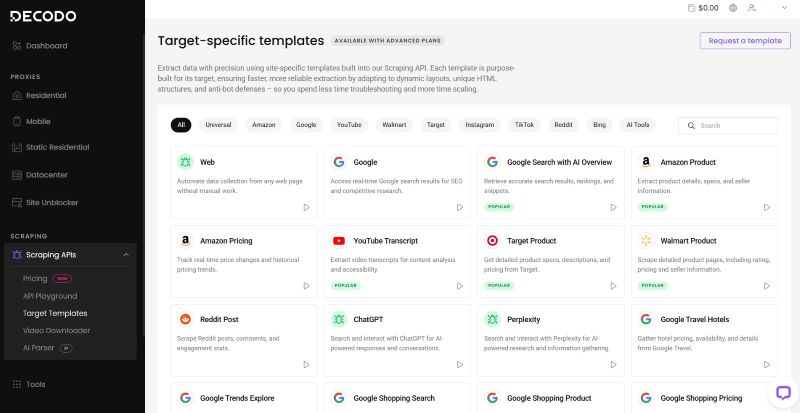Sponsored by Decodo
How companies can use AI to track competitor prices in real-time
Unlocking the power of AI in competitor price tracking and pricing strategies

Every living and thriving business knows the secret of competitor pricing – a practice that involves setting your own product prices according to those of competitors.
This means you are always sitting with your binoculars watching every move made by your competitor.
Let’s say you are a company dealing in 25 SKUs and use manual methods to track competitor prices through sophisticated Excel sheets. By the time an employee reaches the 25th product, the price for the first one would have already changed, making the data obsolete.
Not to mention, this requires an enormous amount of time and effort to visit each competitor’s website, find SKUs, and then compare their prices with previous ones.
Smarter businesses leverage the power of artificial intelligence and machine learning to automate the whole competitor pricing process. Here’s how you can do it too.
Exclusive offer: Get real-time data from any website with Web Scraping API
Start your 7-day free trial with 1K requests and scrape data with a click. Unlock 100+ ready-made scraping templates, 100% success rate, advanced geo-targeting, and automated IP rotation. Don’t miss out – collect data without CAPTCHAs or geo-restrictions.
TechRadar Pro Approved Sponsored Offer
How to use AI for competitor pricing
From collecting competitor data to analysing and making actionable decisions, there’s a lot you can do with AI. Here’s how you can make the most of it.
Data collection
The biggest challenge in effective competitor pricing is actually finding relevant competitor product pages.
For example, if you’re selling ‘Adidas Men’s Running Shoes’, a seller selling ‘Nike Men’s Running Shoes’ would be an indirect competitor, while someone selling formal leather shoes isn’t a competitor at all, although all of them operate in the same broader market segment.
Your only true competitor would be another seller selling the same product with the exact specifications as yours. Now doing this manually again takes a ton of time, which is where AI comes in handy.
It uses advanced web scraping tools and API calls to find relevant product pages across various websites, such as Amazon, Shopify, and eBay, gathering data, such as prices, stock, availability, shipping charges, and so on.

The biggest advantage is that all of this data collection happens in real time, and you can even set alerts based on your own pricing metrics. For example, if a competitor drops the price of a certain product by more than 10%, you may instruct the AI model to send email notifications, highlighting the change.
Real-time analysis
Data collection is just one part of the process. Next up, you’ll need to match the collected data with your own product catalogue for an item-to-item real-time comparison.
Advanced AI models can do this automatically through analysing product descriptions, images, and other attributes, such as colour, material, and style.
After that, it can pull up a side-by-side comparison of your product with several other competitor products without much manual intervention.
AI models are also trained to find pricing trends by analysing the collected data and suggesting pricing changes proactively. For example, AI can quickly pick up that several competitors are increasing their prices during an inventory crunch, suggesting that you do the same.
Now, all of this happens within a few minutes – a task which would usually take you hours or even days to complete.
Dynamic pricing and re-pricing engines
Once you have a complete set of analysed data with key findings and conclusions, you still do not need to update your prices manually. For instance, Amazon can update the prices of millions of products within 10 minutes using repricing engines.
This happens because of preset rules that determine how your prices should change with respect to those of competitors.
For instance, if a competitor increases prices by 10%, your AI engine can be instructed to increase the price of the same product by 7 or 8%.
Price forecasting
Besides a real-time analysis, AI models also have access to tons of historical data, pricing patterns, and event-related sales information. It can dig into these sets of information and forecast your future prices with accuracy.
For example, sophisticated AI models can analyse black Friday sales of the past 10 years and find out by what percentage you should slash your prices to stay competitive.
Besides prices, AI models can also deduce demand patterns during various seasons and how they affect competitor pricing. For instance, whenever Nike launches a new addition, sellers tend to drop prices of older models to clear out stock.
Not only can AI predict this, but also give you a fair estimation of when Nike is going to launch a new product, so that you are prepared in advance.

Vertical integration
AI is just not about analysing and predicting prices. You can vertically integrate AI models through APIs to your own inventory levels and sales data to help with inventory management. This makes it possible for the model to conduct a holistic analysis of your pricing plans, depending on stock availability.
For example, if the model detects that a certain product is running low in quantity, not only will it suggest increasing prices slightly, but also automatically punch in purchase orders.
AI can also predict demand surges and sync your inventory levels with its predictions. For example, if demand for your product increases around the holidays, AI can suggest a restocking even before inventory reaches critical levels.
As an added advantage, AI can analyse even your supplier’s pricing history and offer better negotiating prices.
Final words
The use of AI in competitor pricing unlocks high efficiency, productivity, and accuracy in pricing strategies.
Instead of spending hours on spreadsheets, businesses can now use AI for real-time competitors, price monitoring, price predictions, and pricing automation.
Providers like Intelligence Node and Prisync already offer advanced AI models for competition-based pricing analysis and forecasting.
Dynamic real-time pricing isn’t just an industry edge anymore. It has quickly become a necessity to survive in highly competitive markets. If you want to keep up, AI is your best bet right now.
Sign up to the TechRadar Pro newsletter to get all the top news, opinion, features and guidance your business needs to succeed!
Krishi covers buying guides and how-to's related to software, online tools, and tech products here at TechRadar. Over at Tom's Guide, he writes exclusively on VPN services. You can also find his work on Techopedia and The Tech Report. As a tech fanatic, Krishi also loves writing about the latest happenings in the world of cybersecurity, AI, and software.
